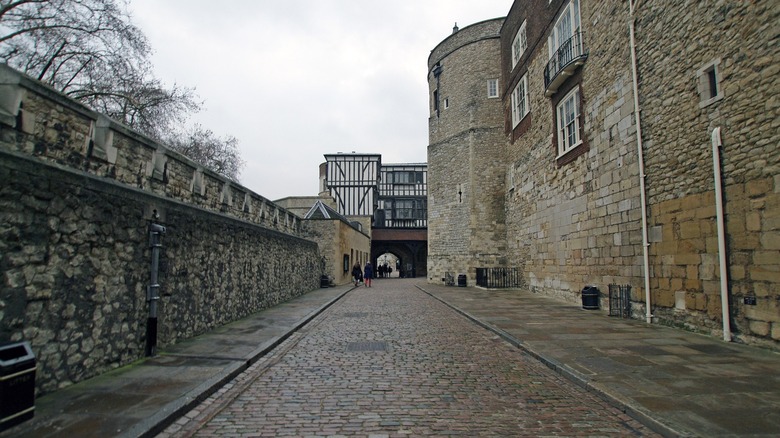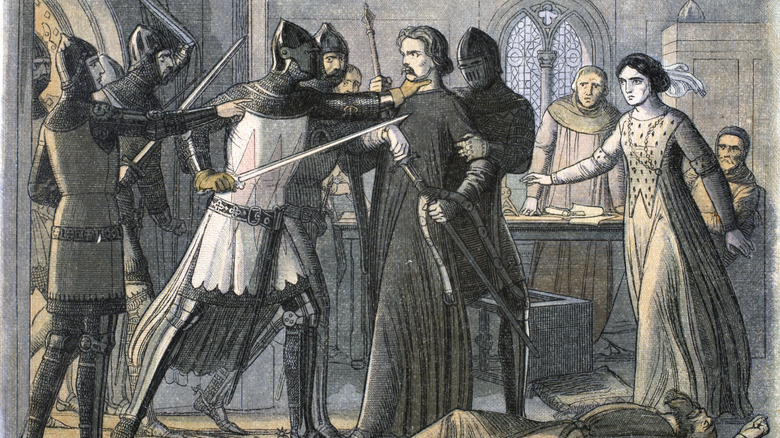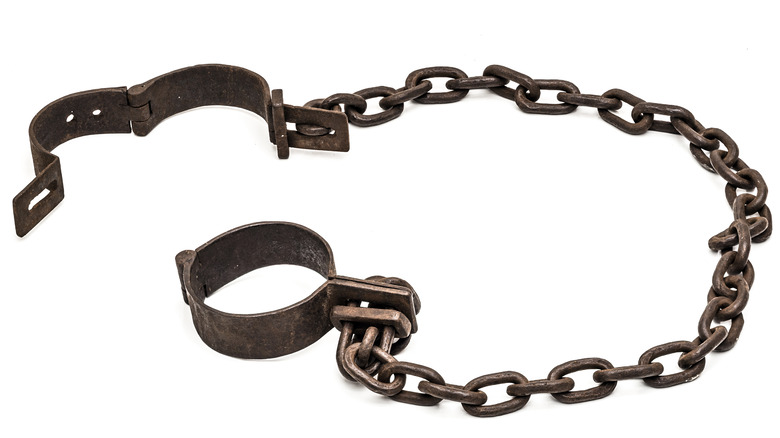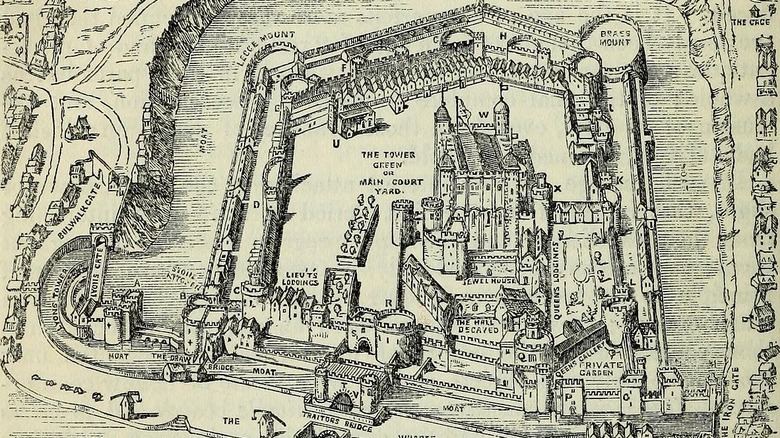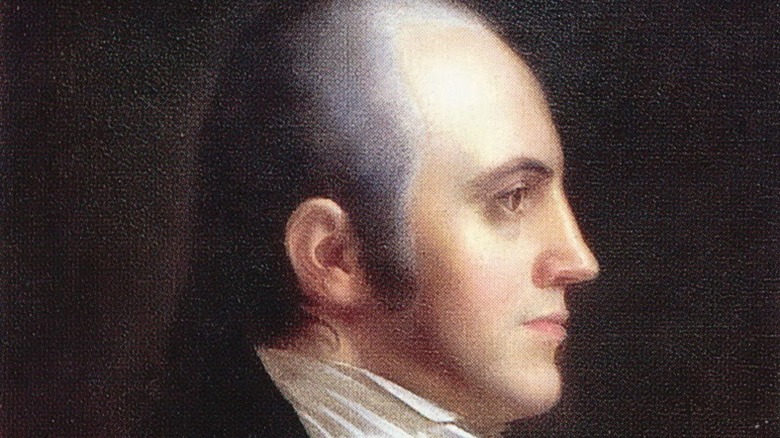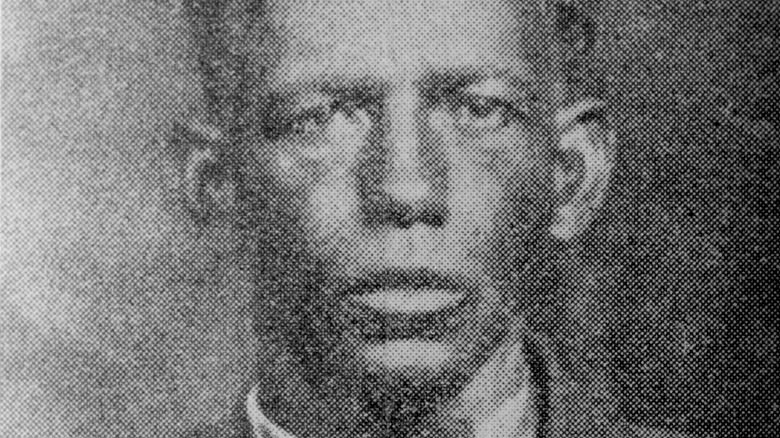
The Craziest Ways Prisoners Escaped The Tower Of London
One of the main tourist sites in the United Kingdom is the Tower of London. According to VisitBritain, there were almost 3 million visits to the historical site in 2019. The reason for its popularity is simple — the Tower of London is an icon of British history. As National Geographic explains, the complex began construction in the 1080s, shortly after William the Conqueror subdued England in the Norman Conquest. William aimed to build an impenetrable fortress to cement his dynasty’s power over London. The first major structure to arise was the famous White Tower, and, in the centuries since, the fortress has gradually expanded, adding more towers and palace structures to its complex. In 1988, the Tower of London was designated a UNESCO World Heritage site.
However, the Tower of London was more than just a defensive structure and probably gained its greatest notoriety as a prison. Guarded by yeoman warders nicknamed the Beefeaters, the Tower held some famous names, including a young Elizabeth I and Guy Fawkes. While the typical prisoner at the Tower of London was often better treated than common prisoners because they had higher status, the structure earned a reputation for torture and execution. It was incredibly difficult to escape the Tower of London, but some people did succeed. These are the craziest ways prisoners escaped the Tower of London.
Medieval England's supermax
As any map of the place shows, the Tower of London was Medieval England’s supermax. The central White Tower is surrounded by open yards and fortifications of multiple towers that only the boldest and luckiest might escape. Added to this is the challenge of water. The Tower is situated on the Thames, and incoming and outgoing prisoners would pass through the waterfront Traitor’s gate. The other sides are surrounded by a moat. According to the City Monitor, the moat never drained properly into the Thames, and the stagnant water was undoubtedly diseased and stank. It was eventually drained in the 19th century.
Because of all these factors, the Tower of London was a terribly hard place to escape from. As reported by Londonist, in its 1,000-year history, there are only about 40 known successful escapes from the Tower of London. Statistically, if you were thrown into the Tower of London, you weren’t coming out. But some prisoners did.
The Tower's first escape
As explained in Stephen Porter’s “The Tower of London,” Ranulf Flambard was a financial administrator of King William II. In the late 1090s, Flambard was designated Bishop of Durham and also made a regent in the king’s absence. However, when William II was killed while hunting in 1100, his younger brother Henry I usurped the throne.
According to “The Mammoth Book of Prison Breaks,” Flambard was thrown in the Tower for extortion, but also because Henry I saw it as good publicity to imprison a person associated with unpopular taxes. Flambard was apparently the first prisoner of the state imprisoned in the Tower of London — somewhat ironic given that he helped oversee the construction of a wall around the Tower.
Flambard’s opportunity for escape came in February 1101, when his friends smuggled in some rope and a flagon of wine. Flambard plied his guards with the alcohol, and the Beefeaters got drunk and passed out. Then, while the guards were snoring, Flambard tied the rope to a column along the window and slid down the outside wall. Flambard burned his hands in his escape, and the rope was too short, forcing him to jump the last several feet. Despite this hiccup, he was fine. His friends were waiting with horses and they hustled him off to a ship bound for Normandy.
Sir Roger Mortimer drugged his guards
Sir Roger Mortimer was a wealthy lord who became enmeshed in the feudal wars of 14th century Britain. According to the New World Encyclopedia, he and some other lords rose up in rebellion to King Edward II. However, in 1322, his army was crushed, and Mortimer submitted himself to the king. While some of Mortimer’s fellows were executed, Mortimer was tossed into the Tower of London.
King Edward must have thought Mortimer finished, but the prisoner had other plans. One account states that the rebellious lord either drugged the guards or used a rope ladder to escape the Tower and fled to France. Another version states that he simply walked out. Regardless, Mortimer wasn’t done with Edward II.
The king’s wife, Queen Isabella, was not happy with the monarch either. She went to France, became Mortimer’s lover, and together they contrived to overthrow and murder the king by suffocating him with a mattress while burning his “secret parts” with a hot plumber’s iron. Some historians believe that they actually just kept the king locked up. Either way, Edward II was succeeded by his son, Edward III, with Mortimer and Queen Isabella acting as regents. In 1330, Edward exercised his independence and had Mortimer arrested and sent back to the Tower. Mortimer was accused of assuming royal power and of other misdemeanors, condemned without trial and hanged in November 1330.
The first and only woman to escape the Tower
As detailed in “A Hidden History of the Tower of London,” Alice Tankerville was involved in the robbery of 366 gold crowns in 1531. The robbery was originally pinned on her common-law husband, John Wolfe, who was sent to the Tower of London. According to “Tales from the Tower,” Wolfe was released for lack of evidence. He left Tankerville and went into hiding. Meanwhile, new evidence materialized that not only implicated Wolfe, but Tankerville, too. Imprisoned in the Tower in 1534, Tankerville waited for her execution shackled in a bare cell. Her situation was so bad that the daughter of the Tower’s lieutenant pleaded for better treatment. The guards removed the shackles, but they kept her locked and isolated.
During this time, Tankerville became friendly with the guards. One guard was fired as a result, but another, John Bawd, fell in love with her and agreed to help. He supplied Tankerville with two pieces of rope, a long stick, and a duplicate key of the Tower’s outer door. One night, Tankerville used the stick to remove the pin from her door and found her way to the outer door, which she unlocked. She made her way to a roof, where she met Bawd. They slipped down ropes and used a boat to cross the moat. But, while they were walking to some waiting horses, members of the watch captured them. Bawd was tossed into the Tower, tortured, and hung over the walls to die from exposure. Tankerville and a re-captured Wolfe were taken to the Thames and chained on an embankment to be executed by a rising tide.
Edmund Neville was a three-time loser who escaped the Tower twice
In 1584, Edmund Neville reported an assassination plot against Elizabeth I. However, as described in “A Hidden History of the Tower of London,” because Neville had a reputation as a Catholic soldier and a family who had rebelled against the Crown, he was thrown into the Tower of London without any evidence.
Neville was treated decently and allowed to wander the grounds, so he became very familiar with the Tower of London and managed to acquire a file. Using the tool, he cut his way out of his cell, climbed over the curtain wall, and swam the moat. He made it to the other side and then out of the city.
Unfortunately, he was eventually caught by a royal horseman. He was sent back to the Tower, this time with leg shackles. However, by 1588, this restriction was relaxed, and by 1590 he was given his old freedoms. He managed to acquire a rope and followed almost the same escape plan but found his old course blocked. He climbed higher, found the rope too short, but dropped into the moat. He made it across but was tracked down and recaptured.
Neville gave it a third go in 1596. As described in “Tower: An Epic History of the Tower of London,” he crafted a straw mannequin and dressed it in his clothes while he disguised himself. Then, when his guard brought food, Neville slipped behind him, out the door, and down the stairs. Unfortunately, neither the mannequin nor the disguise fooled anybody for long. He was caught before leaving the Tower. Neville was eventually released in 1598.
One imprisoned priest used orange juice as invisible ink
John Gerard was a covert Jesuit priest who operated in a spy-like capacity for the Order in England during the 1590s. As summarized in the “Mammoth Book of Prison Breaks,” he was caught and arrested in 1594. He became a focal point for English Catholics to rally around, so he was relocated to the Tower of London in 1597. According to Gerard’s own account, he was tortured by being hung by iron gauntlets. However, he refused to divulge any information.
Eventually, Gerard found a means to communicate with the outside by using orange juice. He wrote seemingly innocuous letters to his friends, but on the same paper, wrote a second letter using orange juice, which was not visible unless it was heated. In this way, he plotted an escape with fellow imprisoned Catholic, John Arden.
One night, the two men were allowed to dine together, and managed to get up on the roof of one of the towers. They had arranged for friends to meet them with a boat, but these friends were delayed by a local man who thought they were fisherman and started chatting with them. The plan was foiled, but Gerard’s friends promised they would come back the next night.
The next night, the two prisoners were amazingly allowed to meet again and pulled off the same caper. This time, they climbed across the moat using a rope that the friends had thrown. Gerard had much difficulty due to the damage his hands had endured during his torture. Gerard and Arden escaped into the city and from there to mainland Europe. Gerard remained overseas until his death in 1637.
William Seymour escaped for love
The Lady Arbella Stewart (sometimes Arabella) was the cousin of King James I. As described by the National Trust, she was in line for the throne of England but had been disinherited through political machinations. In 1610, she secretly married William Seymour. The king did not approve of the marriage since Seymour was distantly related to the prior Tudor dynasty, which he felt made the marriage a threat. Therefore, Seymour was thrown into the Tower of London and Arbella was sent far away to the north.
However, Arbella and Seymour were able to correspond, and planned to escape. Arbella dressed as a man and returned to London in 1611. She made plans for a ship to transport her and her husband to France. According to “Sir William Waad, Lieutenant of the Tower, and the Gunpowder Plot,” she waited on the ship for Seymour. He dressed himself as a workman and walked out of the Tower behind a cart. But the captain of Arbella’s ship would not wait. The ship left but Arbella was hunted down after Seymour’s escape was discovered. Arbella was tossed into the Tower of London and died in 1615.
Two prisoners had help from a loaf of bread
In addition to political prisoners, the Tower of London also held international dissidents. Two of these were the Irish lords and Catholic dissidents Hugh Oge Macmahon and Cornelius Maguire. As described in “A Hidden History of the Tower of London,” the two entered into a conspiracy to seize Dublin Castle, but were caught. Macmahon was subjected to the rack and both men were consigned to the Tower of London. However, they were soon in communication with the outside and plotted an escape.
Help came in the form of two priests (perhaps disguised), who were sent from the Spanish embassy. A plan began to coalesce. Tools, including a saw, were smuggled to the men, and in August 1644 Macmahon received a loaf of bread that contained a note saying that his confederates had hidden a length of rope among the battlements. The two prisoners sawed through their door, found the rope, and slid into the moat.
They escaped, but it proved temporary. Both men were found about a month later. Before Macmahon was hanged, he was asked if somebody should pray for him. He responded, “None but Roman Catholics.”
General John Lambert had a chambermaid stand in for him
General John Lambert was a supporter of Oliver Cromwell. According to the BCW Project, he was an important officer who helped lead Cromwell to establish the short-lived Commonwealth and Protectorate. However, he politically split with Cromwell and was forced to retire. When Cromwell died, Lambert came out of retirement and, in the political infighting that marked the end of the Protectorate, found himself in the Tower of London in 1660.
Lambert, however, had many supporters, and together they contrived an escape that was related in the April 14, 1660 diary entry of Samuel Pepys. Lambert used a rope to escape from his window to a barge, where six of his confederates hurried him across the moat. Meanwhile, the Tower’s chambermaid, Joan, helped out. She slipped into Lambert’s bed and when the yeoman warder came to check on him for the night, she responded in a deep voice, buying Lambert some time. The next day, she was found out. The jailor exclaimed, “In the name of God, Joan, what makes you here? Where is my Lord Lambert?” She replied, “He is gone; but I cannot tell whither.”
Lambert went on to lead a failed attempt to prevent the restoration of monarchial rule. He was captured and spent the rest of his life in prison, but not in the Tower.
John Middleton saw a ghost so dressed in drag
The Scottish politician Lieutenant General John Middleton was the first to escape the Tower of London in drag. Middleton originally backed Roundhead policies during the English Civil War, according to “A Hidden History of the Tower of London,” but after King Charles I was executed, he switched sides and became a royalist. He was one of the commanders of Charles II’s forces at the Battle of Worcester, where he faced off against Parliamentary forces led by Oliver Cromwell in 1651. He lost and was consigned to the Tower of London under “three lockes.”
According to one account, Middleton claimed to have had a dream in which the ghost of his friend, the Laird of Boccini, appeared telling him that he would escape within three days. Not being one to deny a prophecy, three days later Middleton dressed up in his wife’s clothes, which had been smuggled in. He walked out of the Tower. After the Restoration of Charles II in 1660, Middleton was made Lord John Earl of Middleton.
William Maxwell also cross-dressed to escape
William Maxwell, the Fifth Earl of Nithsdale, took a leaf out of Middleton’s book. As explained by the National, Maxwell was arrested for his involvement in the Jacobite rising of 1715. His execution date was set for February 1716, and while he waited, he was imprisoned in the Tower of London. Maxwell’s wife, Countess Winifred, begged King George I for mercy, but he refused. With no other option, she plotted to break her husband out.
When Winifred visited her imprisoned husband, she plied the yeoman warders with money and drink. As such, they were well-disposed to her when she visited on the eve of the Maxwell’s execution. Winifred came with two female companions, one of whom covered her face with a lace handkerchief. In Maxwell’s cell, Winifred applied make up to her husband and provided him with a headdress with the same color hair as that of her companion. Maxwell dressed in a spare set of women’s clothing that his wife had smuggled in, and the group then mingled with a crowd of other visitors. Lost in the shuffle, Maxwell made it out of the Tower and escaped to France.
The last escapees were within living memory
The Tower of London’s heyday as a prison ended in the 18th century, but it was still used to detain prisoners until well into the 20th century. But by the later years, security had become rather lax. In 1919, according to the “Mammoth Book of Prison Breaks,” a subaltern who was imprisoned there for an unclear offense simply left to have a nice dinner in London’s West End. When he returned, he found the Tower locked up, so he simply returned the next morning. The solicitor arguing his case noted that the escape brought attention to the “slackness” in the Tower.
The last reported escapes occurred during the 1940s. According to Londonist, in 1942 two Scots Guardsmen by the names of Fleming and Colvin were held at the Tower. They picked their lock with a fork, lowered themselves into the moat with a rope made from blankets, and crossed a barbed wire fence by covering it with their mattresses. The very last case occurred in 1945. Private L.C. Wheeler was being held in the Tower for striking an officer. He apparently just walked out.

What Really Happened To The Ten Commandments Tablets?

The Crazy Story Of The Scientist Who Sold Nukes To Everyone

How William Shakespeare May Have Helped Steal A Theater
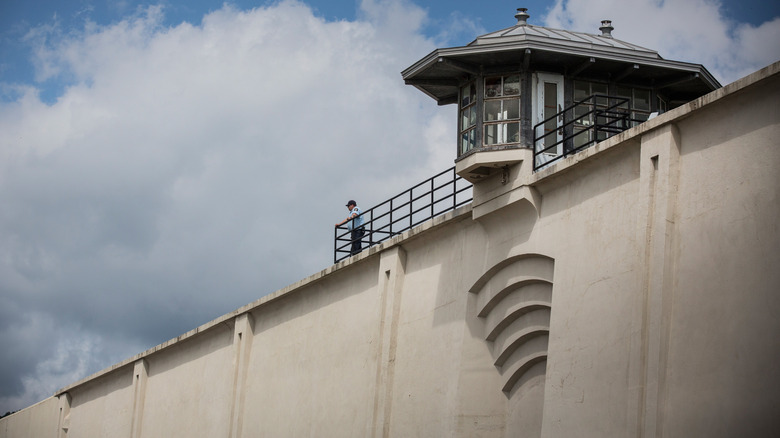
The Truth About The Clinton Correctional Facility Jailbreak

The Crazy True Story Of The Cape Cod Vampire

The Truth About Orson Welles' Difficult Childhood

Olympic Records That Will Probably Never Be Broken

The Truth About George Washington's Teeth

The Tragic Death Of Anne Frank

Albert Fish: Where Is The Serial Killer Buried?

